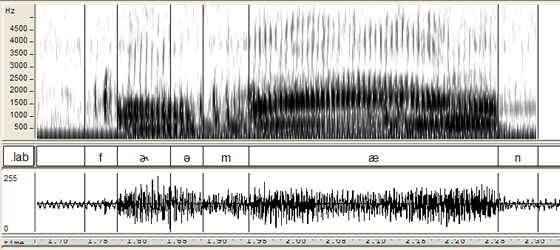October 06, 2006
What Neil Armstrong said
OK, now that everyone is thoroughly sick of all the stuff we've already posted about Neil Armstrong's missing "a", here's a small pile of additional data, some discussion, and a tentative conclusion. I put this data and discussion together because I'm giving a tutorial on acoustic analysis for my introductory linguistics course this afternoon, and I figured that it might add some interest to the exercise if we took a look at the Armstrong case.
[I'm afraid that I use some technical terms like "third formant" and "schwa" without defining them -- if I have time, I'll come back later and make the explanation a bit more self-contained. Meanwhile, if you're really interested, you can refer to Rob Hagiwara's spectrogram-reading tutorial, and the SIL's IPA help page. The rest of you will probably want to read about Malaysian salad language, or the latest manifestation of the Cupertino effect, while you wait for one of us to figure out a linguistic angle on the Foley scandal. Or you can page down to the bottom line, if you want to see what I think about the missing moon-walk mouth movement.]
I searched PodZinger for {"for a man"} and {"for men"}, and picked the first ten examples of each that I found (eliminating mistranscriptions, cases where the audio quality was too poor, non-American accents, etc.). I used "for men" rather than "for mankind" because essentially all the examples of the latter phrase came from discussions of Armstrong's pronunciation, and this seemed too self-referential.
The pronunciations of "for a" in this set fell into three classes:
Type 1: Syllabic [ɹ] -- which could also be viewed as a rhotic or r-colored schwa -- followed by a non-rhotic reduced vowel, of the type that is usually transcribed with the symbol schwa (an upside-down letter 'e'). Note that the third formant (which is low in American English [ɹ]) is already low at the release of the [f], and then rises shortly before the [m]-closure, since the schwa is non-rhotic or at least less r-colored. Examples (1), (2), (6), (7), (8), (10) are of this type.
Type 2: A low back vowel, roughly the quality of "open o" [ɔ], followed by a transition into a typical American [ɹ] (the tongue-blade approximant which is our way of saying /r/), followed by a transition into a schwa. Note that in this case, F3 start out high, moves low for the [ɹ], and then rises again (at least a little bit) for the schwa. Examples (3), (4), (9) are of this type.
Type 3: A rhotic schwa (as in type (1)) followed by a region of glottalization (which emphasizes the existence of the article "a") followed by a less rhotic schwa. Example (5) is of this type.
(In the table below, the audio for each "for a man" segment is linked to the spectrogram, while link to a longer audio clip is available from the sentential context given underneath it.)
| (1) | 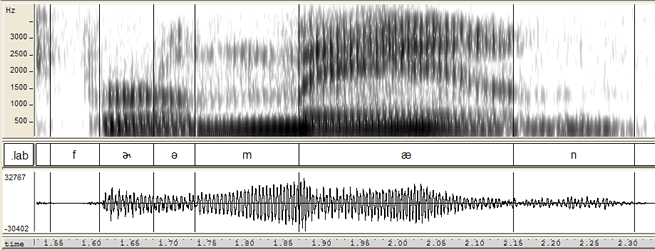 |
(2) |  |
|
| "I think it's the height of arrogance for a man..."[audio] | "Her brother is a man who is house-sitting for a man who plays a man house-sitting on television." [audio] | |||
| (3) |  |
(4) | 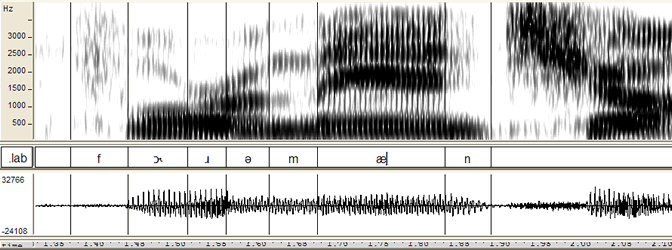 |
|
| "... especially for a man who was known to be gay." [audio] | "that was the bond set for a man charged with murdering two people" [audio] | |||
| (5) |  |
(6) | 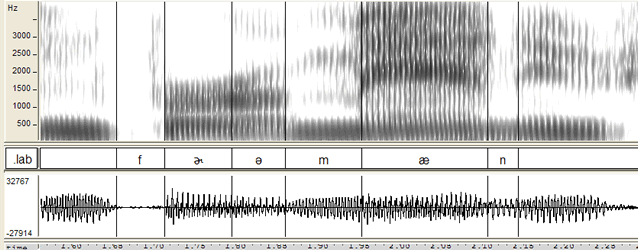 |
|
| "...who was posing as a woman on line looking for a man to fulfill her rape fantasy..." [audio] | "... it's thirty six years in prison for a man who shot and wounded singer-songwriter Mark Coomb last year" [audio] | |||
| (7) | 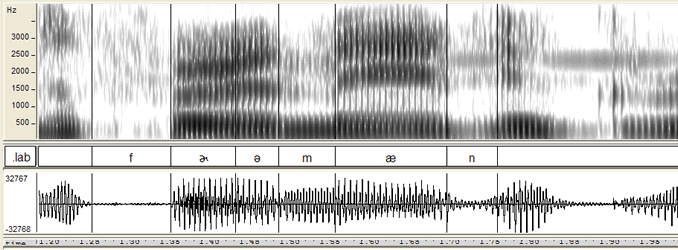 |
(8) | 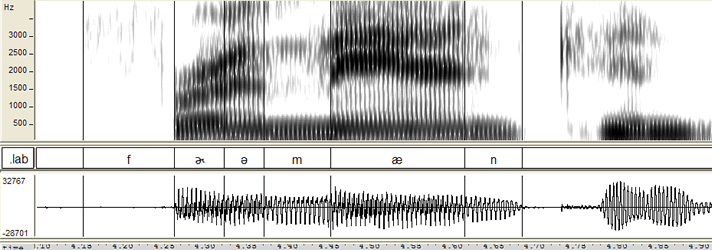 |
|
| "...he's surprising gentle for a man who grew up pushing a giant wheel..." [audio] | "...want the court to reinstate the death penalty for a man convicted of killing a nineteen-year-old woman..." [audio] | |||
| (9) | 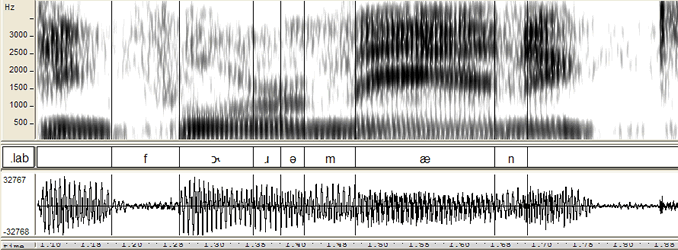 |
(10) | 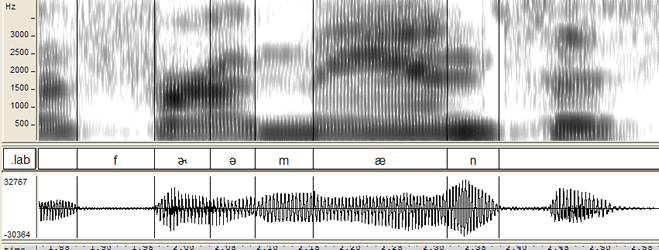 |
|
| "...searching for a man accused of stabbing a homeowner while trying to steal a bike." [audio] | "The search continues in central Florida for a man suspected of shooting two sheriff's deputies" [audio] |
The pronunciations of "for" in "for men" fell into two classes, basically corresponding to types (1) and (2) of the "for a" pronuncations discussed above:
Type 1: the vowel of "for" is just a syllabic /r/ (or rhotic schwa, or what have you), pretty much a monophthong, with F3 low from the start. In the table below, examples (1), (3), (5), (7), (8), (9) and (10) are of this type.
Type 2: the vowe of "for" starts out much less rhotic, with F3 higher, and then transitions into an [ɹ] region with low F3. Example (2) and (4) below are of this type, with example (6) tending a bit in this direction.
| (1) | 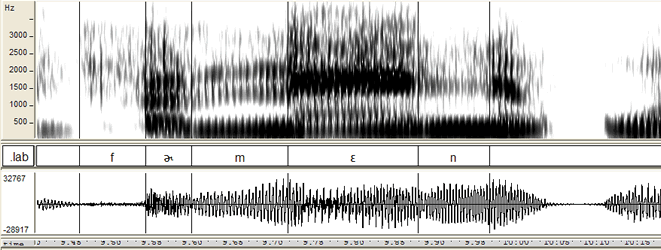 |
(2) |  |
|
| "...stood for 'men with zippers' ..." [audio] | "... that the office of elder is restricted for men..." [audio] |
|||
| (3) |  |
(4) |  |
|
| "... some sort of cosmetic treatment for men." [audio] | "...the difference between writing for men or for women..." [audio] |
|||
| (5) | 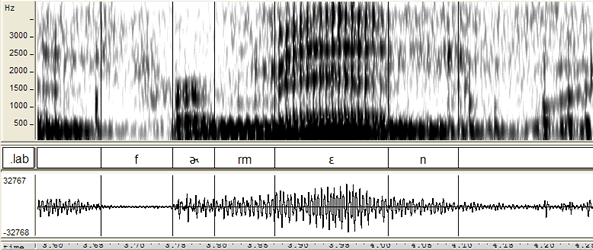 |
(6) | 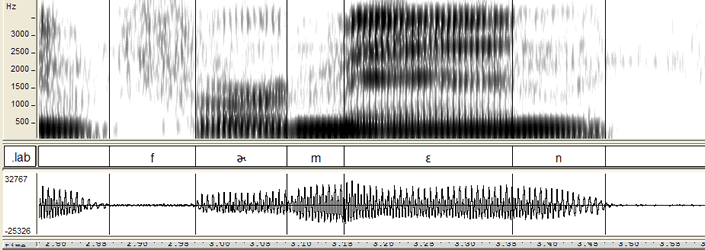 |
|
| "It was a figure of six percent for women and five and a half percent for men..." [audio] | "... you hope it's gonna be the same for men" [audio] | |||
| (7) | 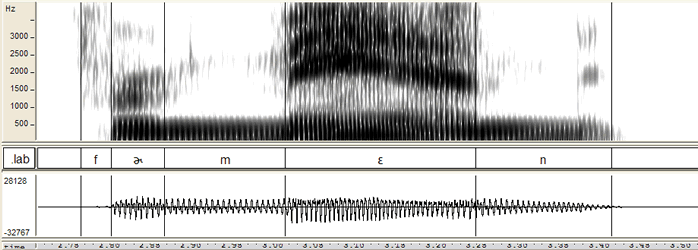 |
(8) | 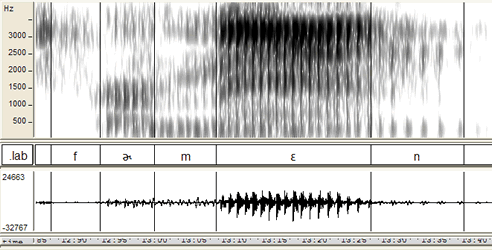 |
|
| "...showed that for men, two thirds of men believed..." [audio] | "...pleasure toys and beer-fetchers for men." [audio] | |||
| (9) | 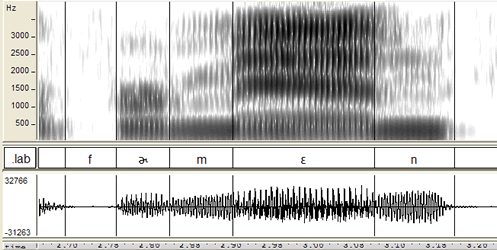 |
(10) | 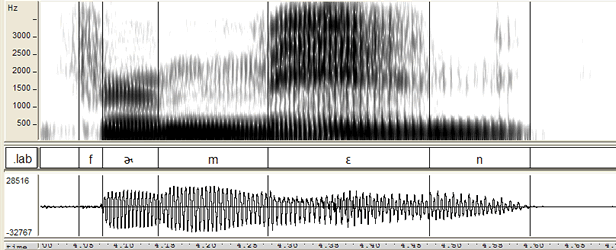 |
|
| "...brought to you by autotrader.com and Milton's the Store for Men." [audio] | "..was also the accusation that the highest level of memberships were reserved for men..." [audio] |
In the case of the "for men" examples, the start of the [m] is often rhoticized as well.
OK, now what about Neil Armstrong's phrase?
Here are the two plausible hypotheses about its analysis.
Hyothesis A: he said "for man", as in the Type (1) pronunciation of the "for men" examples above. This is how most people have always heard it.
Hypothesis B: he said "for a man", as in the Type (1) pronuncation of the "for a man" examples above. This is Peter Shann Ford's hypothesis, as far as I can understand it. I've tried to transfer his transcription into IPA and onto the spectrographic representation below:
The acoustic evidence seems to be against Ford's theory. In particular, there's no indication of the third formant rising at all before the closure of the [m].
And the timing pattern is closer to what we'd expect for the "for man" hypothesis, especially in phrase-final position.
In particular, let's take a look at the stretch from the release of the [f] to the closure of the [m]. In the 10 examples of "for a man", the durations of this region (in milliseconds) were: {125, 137, 343, 245, 197, 155, 142, 116, 161, 124}. The mean of these is 175 msec., SD 71. In the ten examples of "for men", the corresponding regions had the durations {62, 148, 61, 125, 128, 116, 70, 72, 64, 80} milliseconds, mean 93, SD 33.
The duration of this region in Neil Armstrong's pronunciation of "for X man"? 97 milliseconds. A quick calculation suggests that this duration is about four times likelier for "for man" than for "for a man". And if we focused only on phrase-final examples, I think that the preference might be stronger.
My conclusion: I have no doubt that Neil Armstrong meant to say "for a man". And perhaps he produced an unusually rapid performance of the "for a" part, with a brief syllabic /r/ followed by an even briefer and very weakly de-rhoticized schwa. But it seems more likely that what he actually said was just what everyone has always heard, namely "for man".
I would change my mind if it turns out that Armstong often fully assimilates schwa after /r/, or if this is a characteristic of the speech of people in the part of the midwest that he comes from. If anyone knows of any (earthly) recordings of Neil Armstrong's speeches or interviews for me to look at, please let me know.
[Update -- Kevin Marks writes:
I think this is statistically flawed, as Podzinger is using speech recognition software to transcribe the text. Accordingly, searching for 'for a man' you are only going to find examples where the distinction is clear-cut enough for the speech recognition code to have already made this determination.
Thus you have a strong sample bias here.
Fair enough. I also have a rather small sample size. More data from a better sampling method is invited. When I have time, I'll try some other approaches, if someone else doesn't do it first.]
Posted by Mark Liberman at October 6, 2006 06:18 AM
